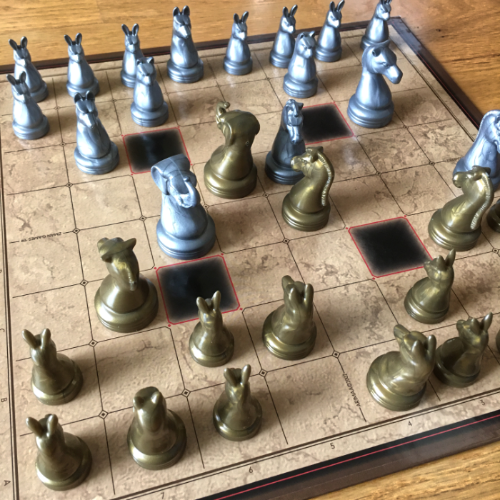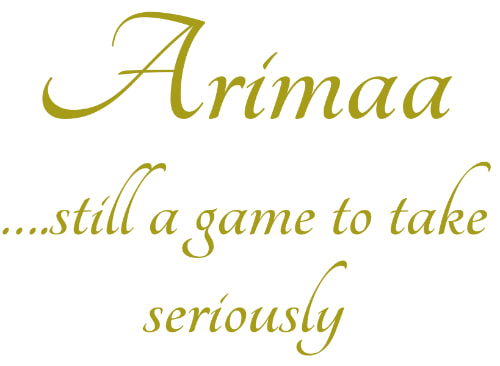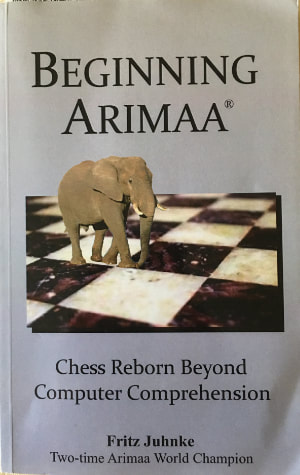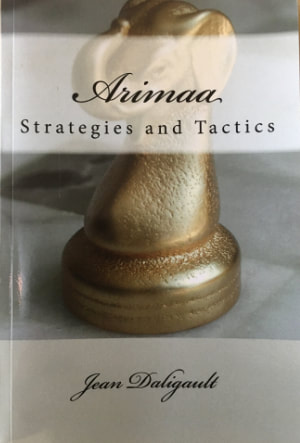Game Literature
Arimaa was developed by Omar Syed in 2002. We covered it in AG16, in 2003, and even in those early days I think there was a recognition of the importance of Arimaa. At the time, Arimaa was touted as a game that would be difficult for AI's to win, and so it was proven to be. Only in 2015 did David Wu's program Sharp defeat the strongest human players. With hindsight, now, from the vistas opened up by Alpha Zero, it is obvious that any of our games can potentially be played by AI's of superhuman strength. Arimaa is no exception.
To be fair, the game's designer never claimed that the machines would not eventually prevail. Nevertheless, much of the early history of Arimaa is coloured by the heroic struggle of human versus machine. The battle is over now. I think we must focus solely on the merits of Arimaa as a game and why we should still consider playing Arimaa.
Of course, Arimaa has a deep strategy and intricate tactics, and we should welcome these ways of making sense of any game. To understand Arimaa, in other words to have some clarity about the game, to have some workable theories about how to play well—see the article in this issue by Christian Freeling on clarity. These theories may be referred to as heuristics—see also the article in this issue by David Ploog. Some games encourage development of these theories, but others are more opaque.
The literature of Arimaa provides us with a shortcut for understanding the game. As we understand the game better, it becomes more enjoyable. The existence of this literature, in addition to Arimaa's qualities purely as a game, is a significant factor in the decision about whether or not to spend any time with Arimaa and take it seriously.
There are not many modern games that have this quality, where very intelligent people have spent a long time studying a game, working out how to play it well, and then writing down this new knowledge for others to follow. Scattered here and there, Hex has a significant literature, and so does Twixt, to a lesser extent. Books have been written about Pente and Reversi. In recent years, I think we can include Hive and Tak in the highly exclusive club of modern games that possess a literature. No doubt there are several more. And of course, there is Arimaa, which now has a relatively long history of thorough investigation. The existence of a literature for any one of these games is a reason for playing it, aside from the merits of the game in itself.
Arimaa is playable with a regular Chess set. However, the Z-man Games version, published in 2009, and shown in the header image, is perfect. It is out of print now, but used copies are easily available. If you plan to play a lot of Arimaa, I would recommend getting hold of one of these custom sets.
To be fair, the game's designer never claimed that the machines would not eventually prevail. Nevertheless, much of the early history of Arimaa is coloured by the heroic struggle of human versus machine. The battle is over now. I think we must focus solely on the merits of Arimaa as a game and why we should still consider playing Arimaa.
Of course, Arimaa has a deep strategy and intricate tactics, and we should welcome these ways of making sense of any game. To understand Arimaa, in other words to have some clarity about the game, to have some workable theories about how to play well—see the article in this issue by Christian Freeling on clarity. These theories may be referred to as heuristics—see also the article in this issue by David Ploog. Some games encourage development of these theories, but others are more opaque.
The literature of Arimaa provides us with a shortcut for understanding the game. As we understand the game better, it becomes more enjoyable. The existence of this literature, in addition to Arimaa's qualities purely as a game, is a significant factor in the decision about whether or not to spend any time with Arimaa and take it seriously.
There are not many modern games that have this quality, where very intelligent people have spent a long time studying a game, working out how to play it well, and then writing down this new knowledge for others to follow. Scattered here and there, Hex has a significant literature, and so does Twixt, to a lesser extent. Books have been written about Pente and Reversi. In recent years, I think we can include Hive and Tak in the highly exclusive club of modern games that possess a literature. No doubt there are several more. And of course, there is Arimaa, which now has a relatively long history of thorough investigation. The existence of a literature for any one of these games is a reason for playing it, aside from the merits of the game in itself.
Arimaa is playable with a regular Chess set. However, the Z-man Games version, published in 2009, and shown in the header image, is perfect. It is out of print now, but used copies are easily available. If you plan to play a lot of Arimaa, I would recommend getting hold of one of these custom sets.
And so, Arimaa has its own literature. The Arimaa Wiki Book is free and extensive. If you have any interest in pursuing Arimaa, I would download the Wiki Book to browse through. My first approach to Arimaa literature, however, was Jean Daligault's Arimaa Strategies and Tactics, self-published in 2012. This book is still available. It is deep and detailed, although difficult for beginners. The author himself recommends first reading the Wiki Book or the earlier print book, Fritz Juhnke's Beginning Arimaa: Chess Reborn Beyond Computer Comprehension, published in 2009 by Flying Camel Publications. Beginning Arimaa is out of print, and more difficult to get and more expensive. Nevertheless, I snagged a copy, and I am glad I did, because this is where I think you should start if you want to get to grips with Arimaa.
Juhnke was clearly still strongly influenced by the human versus machine rivalry, and in this sense the book has not aged well. You may either set aside these aspects of the book and not read them, or read them anyway, because Juhnke's writing is so good and his infectious enthusiasm for Arimaa is apparent on every page. The weight of the book nevertheless lies in its discussion of Arimaa strategy and tactics. Juhnke is one of the very best players that Arimaa has produced, and he has much of interest to say about the strategy and tactics of Arimaa. His writing style is simple and clear.
Juhnke begins with the very basics, simple winning threats, how to get your Rabbit to the goal line, and how to defend against them. It was reminiscent of the advice to Shogi beginners, to study tsume mating problems. Then he covers attacking techniques with traps and how to defend against them. Starting with these elements, the author moves on to explain the necessity for strategic as well as tactical thinking, and subsequently develops various strategic ideas. The content of this book encourages more clarity about Arimaa, which thereby makes the game more enjoyable.
Juhnke uses many examples taken from actual games going back to the very beginnings of serious competitive play of Arimaa. He organizes the elements of Arimaa strategy and tactics in concise chapters, with several examples each from actual play. Perhaps this book can be said to define the elements of Arimaa theory, under headings like "Elephant Smother," "Camel Hostage," and "Efficiency, Balance, and Tension," among many more. No doubt there was much discussion about these ideas among strong players, but Juhnke was the one to pull it all together in this intelligible order.
Juhnke's belief in the depth and significance of Arimaa is present throughout the book. He writes,
"But every time I felt Arimaa had revealed its secrets to me, other players found ways to complicate and surpass my conception of the game, forcing me to look for deeper patterns than before. The Hegelian process of understanding Arimaa strategy is nowhere near to running out of steam.... A few years from now, the strategy I will be trying to execute will be something that today has no name and has not yet been properly described. Arimaa will be popular years from now because, if you devote yourself to it, it will reward your discipline and make you feel that it has been worthy of study. At the end of the road, after Arimaa has grabbed your attention, provided you material to learn, and engaged you with endless synthesis of what you have learned, you will not merely like the game, you will respect it." (pp. 78-79)
That sounds good to me, but he is writing 12 years ago, and interest in Arimaa did not grow as its supporters hoped.
While reading Beginning Arimaa, I enjoyed a fairly good run on the bot ladder on the Arimaa website, and I hope the book will take me still further. In addition to the written materials I have already referred to, the two print books and the Wiki Book, the website itself is a good resource. The website contains a great many high-quality championship games to work through. In addition, it has a bot ladder, and as you get better at the game, you can practice your skills by challenging stronger and stronger bots. And you can find human opponents through the website, too.
Arimaa has achieved at least modern classic status, and after all this time it is gratifying to see the World Championship still running through the website every year. A small community still plays on the website, although you will quickly see that a large majority of the games are against the bots. Of course, the bot ladders are an excellent resource, and a reason in themselves for giving Arimaa a try.
Parts of the website look untended, although you can still access the games to play through them. The interface for games still works perfectly, as do the bot ladders. If the website did ever disappear, Arimaa could be played also on Boardspace.net, and maybe the community would move there. This would be a pity, however, and I hope for further development of the flagship website as well as further progress in Arimaa theory.
The existing Arimaa literature can take you as far as anyone ever gets in understanding any of our beloved abstract games—with the exception perhaps of the traditional games like Chess or Go, which have millions of followers, extensive amateur and professional organizations, and mounds of literature. If you wish to play a game seriously, but don't feel like one of the traditional games, you can give the modern classic Arimaa a try. Play a few games first to get the hang of the rules, read the books by Juhnke and Daligault, and see how far you get on the bot ladder. If you really enjoy the game, there are still options for serious human versus human competition.
In the meantime, we await the arrival of Alpha Zero for Arimaa, which may uncover whole continents of strategy we never knew existed. The irony is, the Alpha Zero scenario may bring Fritz Juhnke's dreams to fruition, but in an unexpected way. I have confidence in Arimaa. In the meantime, there is still Juhnke's book, Daligault's book, the Wiki Book, and whatever else can be found on the website. Arimaa is still a game to be taken seriously.◾️
Juhnke was clearly still strongly influenced by the human versus machine rivalry, and in this sense the book has not aged well. You may either set aside these aspects of the book and not read them, or read them anyway, because Juhnke's writing is so good and his infectious enthusiasm for Arimaa is apparent on every page. The weight of the book nevertheless lies in its discussion of Arimaa strategy and tactics. Juhnke is one of the very best players that Arimaa has produced, and he has much of interest to say about the strategy and tactics of Arimaa. His writing style is simple and clear.
Juhnke begins with the very basics, simple winning threats, how to get your Rabbit to the goal line, and how to defend against them. It was reminiscent of the advice to Shogi beginners, to study tsume mating problems. Then he covers attacking techniques with traps and how to defend against them. Starting with these elements, the author moves on to explain the necessity for strategic as well as tactical thinking, and subsequently develops various strategic ideas. The content of this book encourages more clarity about Arimaa, which thereby makes the game more enjoyable.
Juhnke uses many examples taken from actual games going back to the very beginnings of serious competitive play of Arimaa. He organizes the elements of Arimaa strategy and tactics in concise chapters, with several examples each from actual play. Perhaps this book can be said to define the elements of Arimaa theory, under headings like "Elephant Smother," "Camel Hostage," and "Efficiency, Balance, and Tension," among many more. No doubt there was much discussion about these ideas among strong players, but Juhnke was the one to pull it all together in this intelligible order.
Juhnke's belief in the depth and significance of Arimaa is present throughout the book. He writes,
"But every time I felt Arimaa had revealed its secrets to me, other players found ways to complicate and surpass my conception of the game, forcing me to look for deeper patterns than before. The Hegelian process of understanding Arimaa strategy is nowhere near to running out of steam.... A few years from now, the strategy I will be trying to execute will be something that today has no name and has not yet been properly described. Arimaa will be popular years from now because, if you devote yourself to it, it will reward your discipline and make you feel that it has been worthy of study. At the end of the road, after Arimaa has grabbed your attention, provided you material to learn, and engaged you with endless synthesis of what you have learned, you will not merely like the game, you will respect it." (pp. 78-79)
That sounds good to me, but he is writing 12 years ago, and interest in Arimaa did not grow as its supporters hoped.
While reading Beginning Arimaa, I enjoyed a fairly good run on the bot ladder on the Arimaa website, and I hope the book will take me still further. In addition to the written materials I have already referred to, the two print books and the Wiki Book, the website itself is a good resource. The website contains a great many high-quality championship games to work through. In addition, it has a bot ladder, and as you get better at the game, you can practice your skills by challenging stronger and stronger bots. And you can find human opponents through the website, too.
Arimaa has achieved at least modern classic status, and after all this time it is gratifying to see the World Championship still running through the website every year. A small community still plays on the website, although you will quickly see that a large majority of the games are against the bots. Of course, the bot ladders are an excellent resource, and a reason in themselves for giving Arimaa a try.
Parts of the website look untended, although you can still access the games to play through them. The interface for games still works perfectly, as do the bot ladders. If the website did ever disappear, Arimaa could be played also on Boardspace.net, and maybe the community would move there. This would be a pity, however, and I hope for further development of the flagship website as well as further progress in Arimaa theory.
The existing Arimaa literature can take you as far as anyone ever gets in understanding any of our beloved abstract games—with the exception perhaps of the traditional games like Chess or Go, which have millions of followers, extensive amateur and professional organizations, and mounds of literature. If you wish to play a game seriously, but don't feel like one of the traditional games, you can give the modern classic Arimaa a try. Play a few games first to get the hang of the rules, read the books by Juhnke and Daligault, and see how far you get on the bot ladder. If you really enjoy the game, there are still options for serious human versus human competition.
In the meantime, we await the arrival of Alpha Zero for Arimaa, which may uncover whole continents of strategy we never knew existed. The irony is, the Alpha Zero scenario may bring Fritz Juhnke's dreams to fruition, but in an unexpected way. I have confidence in Arimaa. In the meantime, there is still Juhnke's book, Daligault's book, the Wiki Book, and whatever else can be found on the website. Arimaa is still a game to be taken seriously.◾️



